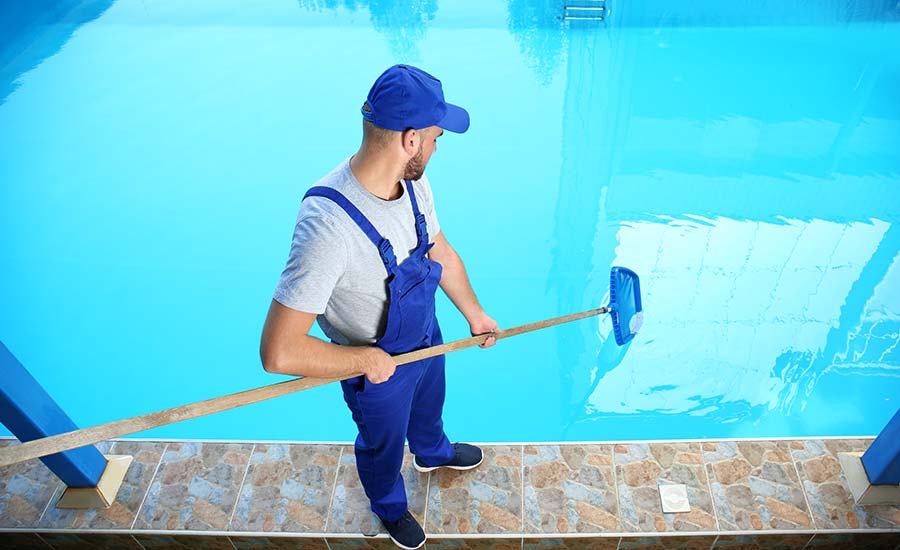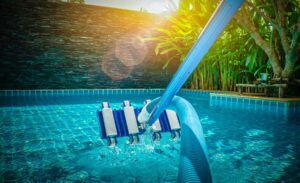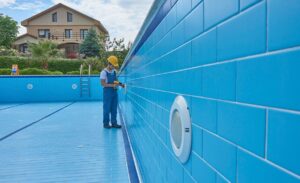
Whether you operate an amusement park, a hotel, a health club or an apartment complex that offers community amenities, a pool maintenance checklist can help you keep your above ground or inground swimming pool clean and crystal clear year-round.
We’ll explain what every pool maintenance checklist should include and provide templates for a daily, weekly, monthly and yearly pool checklist.
Plus, we’ll share how digitizing your checklists with mobile forms can help you save on paper and time, allowing you to stay organized and on schedule.
Digitize your checklists with doForms.
Try doForms for free!
Table of Contents
Key Items Every Pool Maintenance Checklist Should Include
Whether you’re following a daily, weekly, monthly or yearly pool maintenance checklist, there are several items that are key when it comes to pool maintenance. These include:
- Water chemistry: Water chemistry includes the pH level, alkalinity, chlorine and bromine levels, along with calcium hardness and other key water parameters. Ideally, pool PH levels should be between 7.2 and 7.8, while the alkalinity should range between 80 and 120 parts per million (ppm). The concentration of chlorine should be a minimum of 1 ppm while the bromine concentration should be at least 3 ppm.
- Filtration system: A filtration system consists of a pump that circulates the water, a filter that removes debris and a skimmer that collects surface debris.
- Cleaning: Cleaning includes skimming the surface for debris, brushing the pool walls and floor to prevent algae growth and vacuuming the pool floor to remove dirt and sediment.
- Circulation and water flow: A circulation system consists of a pump and plumbing and ensures continuous water flow to distribute chemicals and heat and maintain optimal water quality.
- Equipment and accessories: Including pumps, filters, timers, heaters, automatic pool cleaners, lights and more, pool equipment helps maintain water quality and temperature.
- Deck and surroundings: From a wooden deck to a concrete patio and everything in between, maintaining a pool includes maintenance of the surrounding area to prevent slips, falls and other accidents.
- Safety: From pool fences and gates to first aid kits and lifeguard equipment, pool safety is an important part of maintaining compliance with safety regulations.
Daily Pool Maintenance Checklist
For daily pool maintenance, here’s what your checklist should include:
- Check the water level: Make sure the water level is optimal so that skimmers are functioning properly. Water levels that are too high can cause overflow, while low levels can render the skimmer useless. Add or remove water as needed to maintain the required level.
- Check the water circulation: Make sure the water circulates properly for a distribution of chemicals to maintain consistent water quality.
- Conduct water tests : Test water chemistry parameters, including pH, chlorine/bromine levels and alkalinity. If there are deviations from the required parameters, adjust them as needed.
- Remove debris from the pool’s surface: Use a net or pool skimmer to clean the pool’s surface from leaves, bugs and other floating debris.
- Examine the skimmer and pump baskets: Clean the skimmer and pump baskets by removing leaves or twigs, which can prevent proper water flow and filtration.
- Inspect the pool equipment: Examine pool pumps, filters and heaters for malfunctions, unusual noises and leaks.
- Inspect the safety equipment: Make sure all safety equipment, including rescue poles, life rings and safety signs are in place and easily accessible for emergency situations.
- Cover the pool for the night: Cover the pool every evening to maintain heat and prevent leaves, twigs and other debris from falling into the water.

A daily pool maintenance checklist includes checking the water level and circulation, removing debris and conducting water tests
Weekly Pool Maintenance Checklist
For weekly pool maintenance, here’s what your checklist should include:
- Brush the walls and steps: Clean the pool’s walls, corners and steps to remove dirt, contaminants and algae.
- Vacuum the pool floor: Use a manual or automatic pool vacuum to clean the pool floor after brushing and help the filter system pick up debris.
- Check the filter gauge: Inspect the filter gauge to make sure it reads between 8 and 15 psi. If there are deviations from normal readings, clean the pool as needed.
- Clean the filter: Clean the pool filter following the manufacturer’s instructions.
- Inspect the pool jets: Make sure that the jets operate at full pressure and are oriented down at 45 degrees. Weak jet pressure may suggest a problem with the plumbing lines.
- Clean the deck: Remove dirt, leaves and debris from the deck and surrounding areas to ensure proper drainage and reduce the risk of water accumulation and damage.
- Scrub the tile line: Clean the pool’s tile line to maintain the integrity of the tiles and prevent calcium buildup, staining and discoloration.
- Perform pool shock treatment: Use pool shock or sanitizer to destroy contaminants and prevent algae growth.
- Inspect pool covers: Clean the pool cover and examine it for damage or debris. Make sure it is free of tears and secure.
Ditch the paper checklists and go digital.
Start your free trial with doForms!
Monthly Pool Maintenance Checklist
For monthly pool maintenance, here’s what your checklist should include:
- Deep clean: Clean the pool thoroughly, focusing on the walls, corners, steps and hard-to-reach areas. Brush and remove any stubborn stains or algae.
- Check pool equipment: Inspect filters, heaters, pumps and other equipment for signs of leaks or damage.
- Replace the filter: Deep clean or replace the filter as needed to maintain water clarity.
- Lubricate seals and O-rings: Use a pool-friendly lubricant to oil seals, O-rings and gaskets to help prevent dryness that can lead to cracks or leaks.
- Check the salt cell: If your pool uses saltwater, examine the salt cell for debris and buildup and clean it carefully.
- Conduct a water balance audit: Analyze the pool water’s chemistry and adjust chemical levels as needed to help maintain proper water balance and prevent corrosion.
- Test the water for high metals: Use test kits to establish the level of copper and iron in the water. If these levels are higher than required, take steps to balance the water.
- Test and adjust calcium hardness: Test the calcium hardness level to make sure it’s between 200 – 400 ppm and make adjustments as needed.
- Test salinity: Use a test kit to test the salinity level in your saltwater pool and adjust accordingly, aiming for 2,700 – 3,400 ppm.
- Inspect the pool’s surface: Check the pool’s surface, whether plaster, vinyl or fiberglass for stains, deterioration and cracks.
- Inspect pool lights: Check pool lights and fixtures for malfunction and damage. Replace bulbs where needed to ensure proper illumination and safety.
- Check deck drains: Examine pool deck drains for debris and blockages and if found, clean them to ensure proper water drainage.
- Inspect the pool cover reel system: If you are using a cover reel system, check the reel and straps to ensure they are working properly. Repair or replace damaged components and lubricate where needed.
- Check first aid kits: Check first aid kits and replace any expired items.
- Check pool chemicals storage: Make sure the pool chemicals are properly labeled and organized as well as stored securely. Dispose of any expired or unusable items.
Yearly Pool Maintenance Checklist
For yearly pool maintenance, here’s what your checklist should include:
- Inspect the pool’s structure: Check the walls and floor for cracks, damage and signs of deterioration.
- Examine the pool’s plumbing: Inspect the plumbing system, including pipes, valves and connectors for loose fittings, deterioration and leaks.
- Inspect bolts and screws: Test the stability of diving boards, handrails and slides. Tighten bolts and screws on loose fixtures.
- Clean slide surfaces: Use a slide surface cleaner to remove dirt and algae buildup. Make sure the cleaner is thoroughly rinsed after use.
- Inspect the deck and surrounding areas: Check the pool deck and surrounding area for uneven surfaces, cracks or other safety hazards.
- Check safety features: Make sure pool fences and gates are in good condition and adhere to local safety regulations.
- Evaluate the landscaping: Evaluate the landscaping around the pool to ensure that existing shrubs and trees are not causing debris buildup or posing injury risks. Trim or remove vegetation as needed.
- Plan upgrades or renovations: Consider the need for upgrading equipment, adding new features or improving energy efficiency. Develop a project plan with detailed timelines.
- Organize maintenance records: Collect and archive maintenance records, including pool maintenance checklists, warranties and receipts, to organize and easily track maintenance history.
Common Pool Maintenance Issues and Troubleshooting Guide
Maintaining a pool is not without its challenges. Here’s a quick troubleshooting guide for the most common problems pool owners encounter:
Cloudy Water
- Cause: Unbalanced water chemistry, poor filtration, or high debris levels.
- Solution: Test and balance the water pH, chlorine, and alkalinity. Ensure the filter is clean and functioning properly.
Algae Growth
- Cause: Inadequate chlorine levels or poor circulation.
- Solution: Shock the pool with chlorine, brush all surfaces, and run the filter continuously until clear.
High Chlorine Levels
- Cause: Over-chlorination or improper dosage.
- Solution: Allow sunlight to naturally dissipate excess chlorine, or use a chlorine neutralizer.
Low Water Levels:
- Cause: Evaporation or leaks.
- Solution: Inspect for leaks, repair them promptly, and refill the pool as necessary.
Also Read: Post Construction Inspection Checklist

Your yearly pool maintenance checklist should include detailed inspections of the pool’s structure and plumbing, along with the deck, landscaping and surrounding area
Digitize Your Pool Maintenance Checklists With doForms
doForms is a mobile forms solution that allows you to create and use your own digital checklists, store them securely and retrieve them with the click of a button.
Whether or not you have internet connection, you can use our mobile forms on different devices to edit and share checklists, reports and other documents, attach photos or videos and even capture electronic signatures.
doForms also allows you to synchronize the data collected with other systems to build a centralized database for your business.
Visit our library to choose a checklist template or build your own with our user-friendly interface and drag and drop features.
Whether you need to create pool maintenance checklists, work orders, incident reports, safety audit checklists, employee schedules or other documents, you can do it all with doForms.




